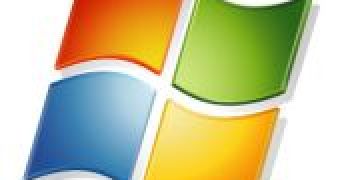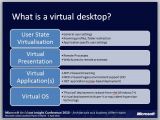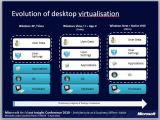A new clue emerged this week pointing out that the successor of Windows 7 is indeed planned for 2012. According to Jason Heyes, Solution Architect, Microsoft, Windows Next will be offered in 2012+, with the information shared in a PowerPoint presentation titled “Desktop as a Service” and shared at the Microsoft Architect Insight Conference 2010 (via Mary-Jo Foley and MA-Config).
Windows Next, in case you were wondering is Microsoft’s way of referring to the next major iteration of Windows without using an actual codename. Another popular choice is Window vNext.
And of course, there’s always the Windows 8 moniker, which the software giant is currently extremely careful not to usher.
The “Desktop as a Service” presentation does provide some indirect confirmation that Windows 8 is planned for availability roughly three years after the release of Windows 7, but it also confirms one other detail that was included in documentation leaked earlier this year.
Heyes mentions the existence of an App Store in relation to a new feature planned for Windows 8, namely Desktop as a Service.
Microsoft has yet to confirm that an application store will indeed accompany Windows vNext to the market, but it makes somewhat sense that the company would consider a central hub set up to house applications designed to play nice with Windows 8.
The App Store is referred to in relation to the evolution of virtualization capabilities in Windows 8, specifically Desktop as a Service.
The actual goals of Windows 8 DaaS are:
“- Enable flexible and policy driven combination of delivery channel, operating system and applications as needed for the given user
- Isolate users, applications and delivery channels into separately managed entities
- Establish the virtual desktop as a concept that spans all possible delivery channels
- Applications and data are centrally managed
- Deployment of application and data is centrally and consistently managed regardless of delivery channel
- Applications and data are treated as cached entities and synchronized with an appstore and “user state store” respectively
- The OS is cached and synchronized with an appstore
- Hardware or other failure is not a critical event for users
- Enable reliable maintenance of applications and OS,” reads an excerpt from the presentation.
And in this regard, it’s important to note that DaaS is much more than just the current virtualization offerings that Microsoft has lined up for customers.
“There is no single right answer on how to deploy and manage the desktop. VDI is not the answer on its own, just as much as a traditional rich desktop is not the answer on its own.
“We have a range of technologies that includes Application Virtualisation (APP-V, MED-V, Remote Apps, Terminal Server), OS virtualisation (Remote Desktop, Terminal Services, VDI), data virtualisation (folder redirection and synchronisation), hardware virtualisation (Hyper-V) and management capabilities (SCCM, SCVMM, SCOM) that should allow us to provide a solution to fit all requirements.
“The basic premise is that a user should receive the right desktop and associated software according to whatever their particular needs are. The desktop should not be associated with the device, the desktop can be thought of as a portal which surfaces the users apps, data, user state and authorisation and access,” Heyes explains.
Essentially, Windows 8 is a piece of Microsoft’s user-centric model that decouples layers of technology, and provides independence from devices.
Customers are currently tied to their devices, and moving to a new, non-configured machine is equivalent to killing productivity completely. Microsoft aims to solve this with DaaS and Windows 8.

 14 DAY TRIAL //
14 DAY TRIAL // 

